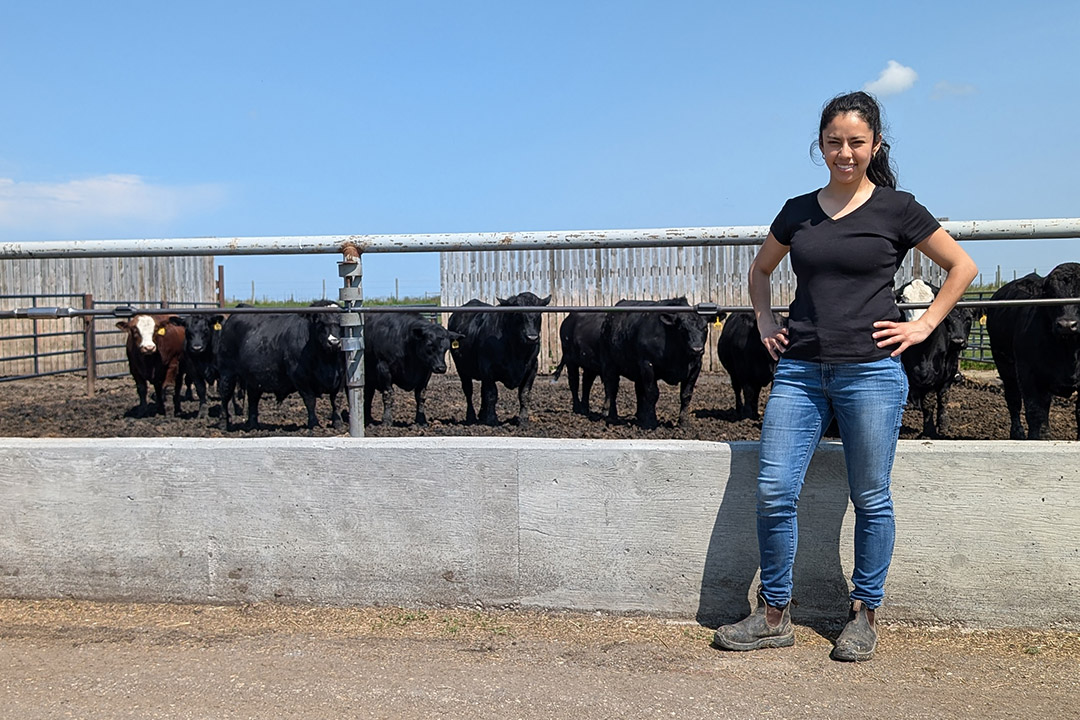
Young Innovators: USask researchers 'beefing' up cattle with affordable, drought-proof diet
Creating a high nutritional value diet that keeps beef cattle fed during challenging years is the focus of University of Saskatchewan (USask) research.
By Erin Matthews, Research Profile and ImpactA good diet is crucial for obtaining high-quality meat from cattle – but drought conditions can make sourcing high-quality feed difficult. USask master student Beatriz Montenegro is searching for feed solutions that are cheaper and easier to obtain for producers, a project that has received funding through the Government of Saskatchewan’s Agricultural Development Fund.
A passion for food production began at a young age for Montenegro. Raised by agronomist parents, Montenegro grew up in Mexico surrounded by a flourishing agriculture industry. Following in her parent’s footsteps, she worked at a beef processing facility shortly after moving to Canada, gaining valuable hands-on experience and learning more about the challenges that beef producers face. Inspired by the industry, Montenegro enrolled at the University of Manitoba, where a biochemistry class helped solidify her choice to focus on animal nutrition.
For the past year, Montenegro has been investigating new diets for beef cattle in the Ribeiro Lab at USask, under supervision of Dr. Gabriel Ribeiro (DVM, PhD) in the College of Agriculture and Bioresources.
“There are so many little biochemical details and intricacies that you can investigate and tweak to get results,” said Montenegro. “From a producer’s point of view, if you make a small change in an animal’s diet, you can get tangible changes in the animal.”
When it comes to beef cattle, diet changes can affect meat composition, including marbling, which is important for determining the quality of the meat. In Canada, producers aim for higher quality grading like prime and AAA.
“The challenges faced by producers have been exacerbated by the unprecedented drought in Western Canada,” said Montenegro. “I’ve heard from people who have ranched for generations who have to sell off or downsize their operations to maintain their viability.”
Montenegro saw potential and opportunity in cheaper byproducts from wheat and oil crops which can be used to alleviate some of the economic strain caused by high feed prices.
“Our research team wanted to see if we can take advantage of using these crop byproducts that are economical and widely available in Western Canada and include them in beef cattle diets without compromising growth performance,” said Montenegro.
Montenegro was specifically interested in wheat straw, a crop byproduct that is widely available and costs less than normal feed but has a lower nutritional value. But feeding cattle only wheat straw has its limitations.
“A similar comparison would be to feed only lettuce to a high-performance athlete” said Montenegro, “It has lots of fibre, but not a whole lot of nutrition by itself.”
To improve the nutritional profile of wheat straw, Montenegro added in fats from another crop byproduct—canola or flax screenings.
These fats not only work to supplement the cattle’s diet, but they can reduce the production of methane, a greenhouse gas that is produced by the beef cattle industry.
With her research, Montenegro hopes to provide a more inclusive picture of different diets for producers by looking at cattle performance, economics, greenhouse gas emissions and how diets are digested.
“I’m very passionate about applied research and knowledge transfer from academia to industry,
said Montenegro. “Helping producers improve operational efficiencies and increase animal health and welfare is really important for me as a researcher.”
This article first ran as part of the 2024 Young Innovators series, an initiative of the USask Research Profile and Impact office in partnership with the Saskatoon StarPhoenix.
Together, we will undertake the research the world needs. We invite you to join by supporting critical research at USask.

